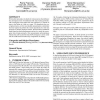134
click to vote
ICDCS
2011
IEEE
14 years 9 days ago
2011
IEEE
Abstract—Intentional interference constitutes a major threat for communication networks operating over a shared medium where availability is imperative. Jamming attacks are often...
109
click to vote
CORR
2011
Springer
14 years 7 months ago
2011
Springer
We consider a consensus algorithm in which every node in a time-varying undirected connected graph assigns equal weight to each of its neighbors. Under the assumption that the deg...
111
Voted
ICASSP
2010
IEEE
14 years 11 months ago
2010
IEEE
Performing distributed consensus in a network has been an important research problem for several years, and is directly applicable to sensor networks, autonomous vehicle formation...
99
Voted
CCR
2005
15 years 18 days ago
2005
We describe and analyse in details the various factors that influence the convergence time of intradomain link state routing protocols. This convergence time reflects the time req...
111
Voted
SODA
2008
ACM
15 years 2 months ago
2008
ACM
We analyze several distributed, continuous time protocols for a fair allocation of bandwidths to flows in a network (or resources to agents). Our protocols converge to an allocati...
105
Voted
NETWORKING
2008
15 years 2 months ago
2008
The decentralized control scheme for routing in current IP networks has been questioned, and a centralized control scheme has been proposed. In this paper, we compare the convergen...
125
Voted
ATAL
2006
Springer
15 years 4 months ago
2006
Springer
We study how decentralized agents can develop a shared vocabulary without global coordination. Answering this question can help us understand the emergence of many communication s...
96
Voted
INFOCOM
2002
IEEE
15 years 5 months ago
2002
IEEE
—BGP allows routers to use general preference policies for route selection. This paper studies the impact of these policies on convergence time. We first describe a real-time mo...
92
Voted
INFOCOM
2003
IEEE
15 years 6 months ago
2003
IEEE
— In [1], [2] it was noticed that sometimes it takes BGP a substantial amount of time and messages to converge and stabilize following the failure of some node in the Internet. I...
96
Voted
IPCCC
2006
IEEE
15 years 6 months ago
2006
IEEE
The duration of the Minimal Route Advertisement Interval (MRAI) and the implementation of MRAI timers have a significant influence on the convergence time of the Border Gateway Pr...

